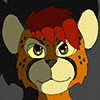Ask about Vern
5 years ago
While my free time limits my art output to a bit of a crawl, I thought I'd open up to questions about my characters and their setting.
Anything you want to know about the world of Vern, or about Firros, Vayne or whoever else that lives there.
Questions will be answered as soon as time permits.
Anything you want to know about the world of Vern, or about Firros, Vayne or whoever else that lives there.
Questions will be answered as soon as time permits.

 FA+
FA+

The earliest civilizations belonged to canids and felids, being the penultimate carnivores and driven by evolution to form societies that enabled easier methods of survival. Smaller races developed along a similar evolutionary path, but due to their size were often preyed upon by the larger predators. Those that scavenged or hunted by opportunity also found their way to sapience, but were often the bottom of the food chain compared to the other sapient races that lived above them.
To provide a general rule of thumb, the breeds that reach sapience are typically carnivorous or omnivorous, or have a genetic link to breeds of that nature. All breeds of canine and feline are sapient, as well as all breeds of ursine. All mustelids, all rodents, and various small races of a similar physiology such as rabbits also took part in this evolutionary path.
As for who consumes who? Generally speaking, larger felids won't consume their smaller cousins due to long standing traditions of kinship, and a similar principle applies among canids and mustelids respectively. Though no laws on the matter are set in stone, for the most part predators only target those that are about a third of their own size at most. This is mostly for practical reasons, as an otter trying to bring in a rabbit their own size for example, presents a number of difficulties. Most denizens of Vern are capable of consuming prey of this size difference whole, but any bigger than that becomes a problem. A cheetah for example may find that the much smaller rabbit fills their belly almost perfectly, but a slightly larger otter or hare is too difficult to swallow and then stretches their stomach to an uncomfortable degree.
Generally speaking, prey is no bigger than one third the size of the predator that consumes them. Most of the time, it's roughly one quarter the size or smaller. Not all prey are consumed alive, as predator preferences vary. Some love the feel of live prey inside them, while others find far more satisfaction in killing and consuming their prey in pieces.